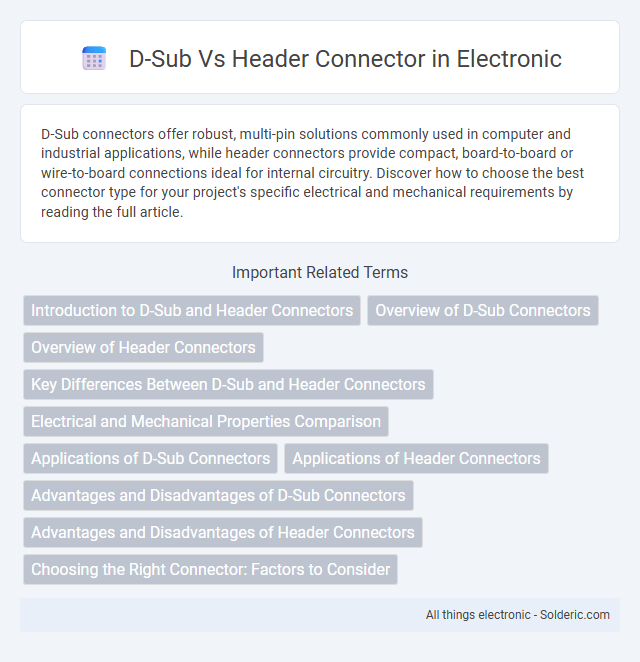D-Sub connectors offer robust, multi-pin solutions commonly used in computer and industrial applications, while header connectors provide compact, board-to-board or wire-to-board connections ideal for internal circuitry. Discover how to choose the best connector type for your project's specific electrical and mechanical requirements by reading the full article.
Comparison Table
| Feature | D-Sub Connector | Header Connector |
|---|---|---|
| Definition | Multi-pin connector with D-shaped metal shield for alignment and protection | Connector with pins arranged in a single or double row, mounted on PCB |
| Common Usage | Serial ports, VGA cables, industrial equipment | Internal connections on PCBs, ribbon cables, motherboards |
| Pin Count | Typically 9, 15, 25 pins | Varies widely; pins range from 2 to 40+ |
| Physical Size | Medium to large size, robust | Compact and customizable size |
| Mounting Method | Panel mounted or cable mounted | PCB mounted |
| Shielding | Metal D-shell provides EMI protection | Typically lacks metal shielding |
| Durability | High durability with secure locking screws | Moderate durability, relies on PCB soldering |
| Cost | Generally higher cost | Lower cost, suitable for mass production |
Introduction to D-Sub and Header Connectors
D-Sub connectors, characterized by their D-shaped metal shield and multiple pins, are commonly used for serial and parallel ports in computing and industrial applications. Header connectors consist of a row or grid of pins on a PCB designed for quick and reliable connections with ribbon cables or other wiring systems. Both connector types facilitate secure electronic connections, but D-Sub connectors offer robust shielding while header connectors provide flexibility in circuit board design and assembly.
Overview of D-Sub Connectors
D-Sub connectors are widely used in computer and communication devices for their reliable multi-pin connection, featuring a D-shaped metal shield that ensures proper alignment and durability. These connectors typically support various pin configurations, such as 9, 15, 25, or 37 pins, making them versatile for serial, parallel, and network interfaces. Your choice of a D-Sub connector guarantees secure and stable connectivity in environments requiring robust electrical performance and mechanical stability.
Overview of Header Connectors
Header connectors feature a row or multiple rows of pins installed on a printed circuit board, serving as an interface for easily connecting cables and devices. They provide reliable and customizable connections suitable for various electronics applications, including computer hardware and industrial equipment. Your project benefits from the compact size and straightforward soldering process of header connectors, offering efficiency and flexibility in PCB design.
Key Differences Between D-Sub and Header Connectors
D-Sub connectors feature a metal shell and multiple pins arranged in a trapezoidal shape, providing robust mechanical stability and shielding for reliable data transmission. Header connectors consist of rows of pins or sockets typically mounted on PCBs, designed for quick mating and high-density connections but generally offer less mechanical protection. The primary difference lies in D-Sub's suitability for external device connections requiring durability, while header connectors are optimized for internal board-to-board or cable-to-board interfaces.
Electrical and Mechanical Properties Comparison
D-Sub connectors offer robust electrical performance with reliable signal integrity across multiple pins, often supporting high-frequency transmission and shielding against electromagnetic interference. Header connectors provide a compact design that optimizes mechanical fit within PCBs, featuring a simplified pin arrangement that may limit current capacity but allows easy mating with ribbon cables or daughterboards. Your choice depends on balancing the need for durable, high-current electrical connections with space-efficient mechanical integration.
Applications of D-Sub Connectors
D-Sub connectors are widely used in computer and telecommunications equipment for serial and parallel data transmission, offering reliable connections in devices like monitors, printers, and modems. Their robust design suits industrial automation and aerospace applications where secure, vibration-resistant connections are critical. These connectors also support legacy systems, providing compatibility and ease of integration in various control and networking environments.
Applications of Header Connectors
Header connectors are widely utilized in PCB assembly for establishing reliable connections between circuit boards and peripheral devices in consumer electronics, industrial equipment, and automotive systems. They facilitate easy installation and maintenance in applications such as embedded systems, microcontroller boards, and internal component interfaces. Their versatility and compact design make them ideal for signal, power, and data transmission in densely packed electronic layouts.
Advantages and Disadvantages of D-Sub Connectors
D-Sub connectors offer robust mechanical strength and reliable multi-pin connections, making them ideal for industrial and computer communication applications. Their disadvantages include bulky size compared to modern connectors, limited shielding against electromagnetic interference, and potential difficulty in mating and unmating due to screw-lock mechanisms. Despite these drawbacks, D-Sub connectors provide excellent signal integrity and durability in demanding environments.
Advantages and Disadvantages of Header Connectors
Header connectors offer compact and reliable connections ideal for PCB applications, providing easy soldering and a secure fit with mating connectors. Their main advantage is simplified assembly, enabling quick installation and maintenance, though they may present limited durability and weaker locking mechanisms compared to D-Sub connectors. For Your device, choosing header connectors ensures streamlined design integration but requires careful consideration of mechanical stress and environmental factors.
Choosing the Right Connector: Factors to Consider
When choosing between a D-Sub and a Header Connector, consider factors such as signal type, pin density, and mechanical durability, as D-Sub connectors offer robust shielding for analog and digital signals while Header Connectors provide compact, PCB-mounted solutions. Your decision should reflect the application's environmental conditions, ease of assembly, and space constraints, with D-Sub connectors often preferred for industrial use and Header Connectors for internal electronic connections. Evaluating current capacity and mating cycles ensures optimal performance and longevity for your specific hardware needs.
D-Sub vs Header Connector Infographic

 solderic.com
solderic.com